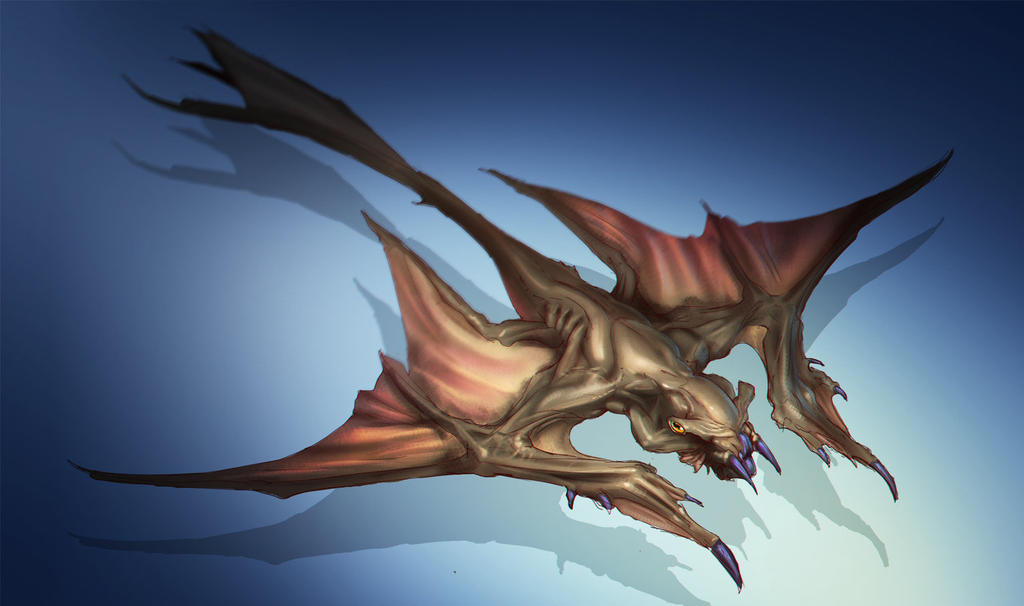Directorate Officer

Intent: To create an engineered version of the common mynock to use as a guard animal
Image Credit: “Mynock Hunter” by MeckanicalMind, (Source: https://meckanicalmind.deviantart.com/art/Mynock-Hunter-438753097)
Canon: N/A
Links: Lucerne Biological Systems, Mynock
Name: Hunter Mynock
Designation: Non-sentient.
Homeworld: Lur (Lucerne Biological Systems facility)
Language: None
Average Lifespan: 6 years
Estimated Population: Scattered
Description: The Hunter Mynock is a strain of the common mynock specifically genetically engineered to act as a spacebound guard creature. Most spacers can't differientate between a Hunter Mynock and a Mynock at a glance and there are few external differences between the two. Most of the genetic engineering altered the creature's mind to make its training easier, though the Hunter Mynock's talons are also slightly larger and more dense than that of an average mynock. Flocks of Hunter Mynocks are typically sold by Lucerne Biological Systems as a low-maintenance defensive measure for space stations and asteroid colonies.
Breathes: None
Average height of adults: 1.4 meters
Average length of adults: 1.4 meters
Skin color: Tan to gray
Hair color: None
Distinctions: Hunter Mynocks appear to be vaguely birdlike creatures with reptilian ancestry, with taut tan or gray skin covering an irregularly muscled body. As mynocks reproduce asexually, various in size or skin color is largely the result of random mutations. As Hunter Mynock grow older, their skin becomes less lustrous and their muscles atrophy, leading to easily seen wrinkles of skin in their wings.
Races: None
Strengths:
Trainable: The Hunter Mynock is capable of being trained through simple behavorial modification methods (giving out treats, punishments, etc) or memory-imprintation. By combining stimuli cues with behavioral response, Hunter Mynocks can be trained to attack certain targets or leave others alone. Since Hunter Mynocks do share their memories through telepathy, it is possible for an entire group of the creatures to be collectively trained by directly training only a few individual Hunter Mynocks.
Silicon Biology: Like typical mynocks, having a silicon biology means that the Hunter Mynock doesn't need air to breathe nor does it require typical food to survive. It can simply hang out in the vacuum of space and absorb stellar energy or latch until an artificial source of power for sustenance.
[*]
Weaknesses:
Spacebound: Like normal mynocks, a Hunter Mynock cannot survive in an atmosphere of a world for long. If the atmosphere doesn't get them, the gravity soon will weaken and tear their joints, wings, and ligaments before they ultimately succumb to their injuries.
Allergic to Helium: Like the common mynock, exposure to helium causes Hunter Mynocks to quickly expand and then violently burst.
CULTURE
Diet: typically electrical, stellar, and electromagnetic energy
Communication: Hive mind (telepathy)
Technology level: None
Religion/Beliefs: None
General behavior: The Hunter Mynock is little evolved from its predecessor, the common Mynock. Like its precursor, the Hunter Mynock spends most of its time scavenging for food, eagerly basking in stellar radiation or pouncing on vessels unauthorized to be in their habitat. Hunter Mynocks have been engineered to focus communicating as a hive mind, meaning that the individual knowledge of one source of sustenance is quickly communicated across the whole group. Some of the oldest (and most intelligent) of the Hunter Mynock strain have been observed to engage in play with games similar to tag.
HISTORICAL INFORMATION
The Hunter Mynock was originally conceived by Lucerne Biological Systems as a way to provide security inhouse for deep-space caches of medicines awaiting pickup by freighters to other worlds. After collecting a number of mynocks from visiting and infected light freighters, Lucerne Biological Systems mapped the creature's genome and spliced what they believed to be more the most ideal traits of each individual mynock into a single genetic template. This proved to be challenging at first because unlike many lifeforms, mynocks are silicon-based. This mean that they were not able to heavily modify the creatures that far from their base form because of the relative rariety of that type of lifeform and a lack of experience in that type of biological chemistry: the relative traits of the Hunter Mynock could have been as easily obtained by traditional breeding, though that would have taken more time. The first batch of Hunter Mynocks were trained in specifically quarantined area of deep space through the use of basic behavioral modification. This training proved to be longer and costlier than expected. Subsequent batches of Hunter Mynocks were memory-imprinted with these memories as they were grown in cloning vats to speed up the training process. In order to recoup their losses in the project, Lucerne Biological Systems decided to sell Hunter Mynocks through defense industry contacts cultivated by its parent company, Lucerne Labs. Flocks of Hunter Mynocks have since found their way across the galaxy as a sort of auxiliary security force to deep space locations such as asteroid bases and space stations. While more of a nuisance than a threat on an individual level, groups of Mynock Hunters can be a real force-degrader to enemy ships as they suck drain power from vessels and eat their way through a ship to get at power cables. Oftentimes a potential Hunter Mynock infestation on a ship is enough of a deterrent to keep low-level raiders away. To date, the largest population of Hunter Mynocks are the flocks which populate the asteroid belt around Ceraluen as part of Admiral Quee's initiative to fortify the world as his Fourth Fleet's home port.









